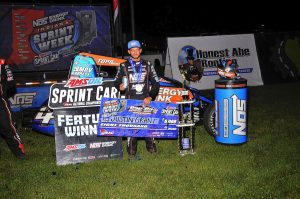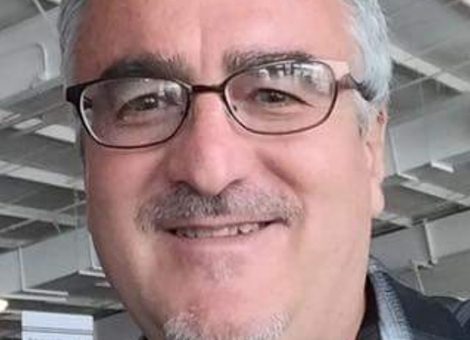INDIANAPOLIS — It doesn’t matter when it happens or where it happens, only that it does happen. And when it does — when you first see that racing is not a game of machines, but rather of people — that is when the hook is set.
From there, racing just pulls you in, as deep as you want to let it take you.
I was reminded of that the other night, in the middle of USAC’s Indiana Sprint Week, a dirt-track carnival that drags teams and fans to eight Hoosier speedways in nine nights. It was all there on the face of a young boy walking through a pit area after a race, eyes wide with wonder.
A brief backstory: I am one of those fortunate humans who sneaks through decades of life without having children, but ends up a grandparent anyway. There’s no real trick to it; you marry someone who has a couple of grown kids, and from there things take care of themselves.

So without ever having changed a diaper or dealt with a lousy report card, I have someone who calls me grandpa. And now that little someone, 10-year-old Colton, was staring up wide-eyed at Justin Grant, the reigning USAC sprint car champion, who was autographing Colton’s new T-shirt.
Although photos prove that he’d attended some races in the past with an uncle, Colton doesn’t recall any of that. But watching him navigate the pits, clutching that T-shirt and a toy sprint car his grandma had bought him, I guessed he might remember this night for a while.
In addition to Grant, he’d met drivers Dave Darland and Logan Seavey and chatted with veteran mechanic Jeff Walker.
“I work on that car,” said Walker, nodding toward Grant’s blue sprinter.
“Cool,” said the boy, drawing out the word the way kids do.
It was dawning on him that all the colorful cars he’d just watched were not just bigger, louder versions of the toy in his hands. This was something real. People drove these cars. Other people worked on them, fiddling with engines, measuring things, scraping mud. And when the last race ended, people rolled the cars into giant trailers and stood around talking about how things had gone.
I can’t imagine that it all made sense to him. But it seemed to me that a light had been switched on, just as there was once a light-switch moment for you, for me, for all of us.
In my case, it happened 50 summers ago in a small garage where a handful of adult males hovered over a black coupe-bodied modified. It belonged to Tom Ormsby, who raced it on Saturday nights at a Connecticut bullring called Plainville Stadium. I had been to Plainville many times, but at 13 I was too young for a pit pass. A neighbor girl dated a guy who worked on Ormsby’s crew and when she asked one evening if I wanted to see where they kept the car, I jumped at the chance. We had different agendas, of course. She wanted to see her guy and I wanted a close-up peek at that coupe.
I examined every inch of it, from its stark interior outward to its front and rear bumpers. But mostly I watched those men work on it.
After that garage visit, racing never looked the same to me. I had no skin in the game, but I now understood that many people did. If Plainville Stadium drew 30 modifieds and 30 more cars in its full-bodied support class, and each of those cars had a crew of five, there were 300 people intimately involved in what I watched every Saturday.
I’d read in one of the trade papers I’d bought that there were something like 700 short tracks across the United States. Quick math said that more than 200,000 people were hovering over race cars on Tuesday nights and Thursday nights.
Just like that, racing changed for me.
I can’t imagine that Colton felt the same jolt I experienced in 1973. He belongs to an overstimulated generation fueled by video games and YouTube clips, so racing has some fierce competition if it wants to grab him. But he insisted on wearing his Justin Grant shirt to bed and he wore it again the next night when, via livestream, he watched Grant drive to victory.
He was certain that by wearing that T-shirt, he had somehow contributed to Grant’s winning effort. No one in his family was going to suggest otherwise.
As always, Indiana Sprint Week was full of buzz. For Jake Swanson and Emerson Axsom, 24-hour redemption was a theme: Swanson flipped at Terre Haute and won the next night at Lincoln Park, while Axsom missed the Lincoln Park feature on Thursday and won at Bloomington on Friday. Mitchel Moles walked away from a Kokomo crash that sawed his car in half just ahead of the engine.
Grant won three of the seven ISW features — the Haubstadt finale rained out — but the series title went to consistent Brady Bacon.
Something tells me that in my long-term memory, all of that will take a back seat to the sparkle I saw in Colton’s wide eyes as he stared up at Darland, Seavey, Grant and Walker. Not because he’s my grandson, but because he is a 10-year-old who rode home that night in love with everything he’d seen. I’ll remember that and I’ll smile.
So this is not one of those sappy columns that ends by suggesting you take a kid to the races because it’s good for the track, or good for the sport. Sure, that might be true. But I think you’ll find that it can be pretty damn good for you, too.
This story appeared in the August 9, 2023 edition of the SPEED SPORT Insider.

